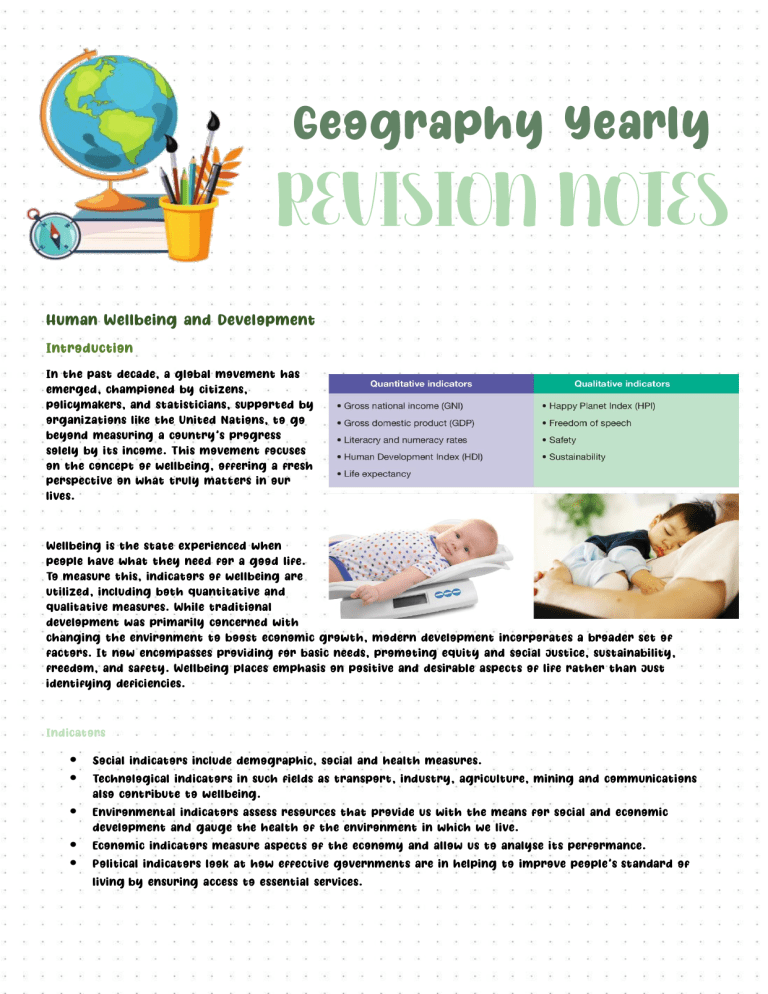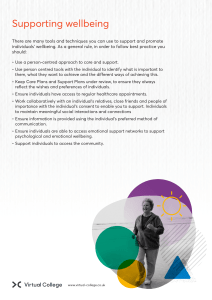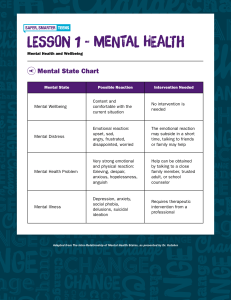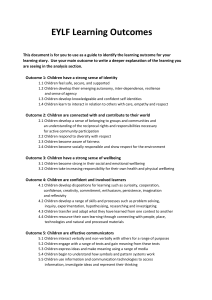
Geography Yearly Human Wellbeing and Development Introduction In the past decade, a global movement has emerged, championed by citizens, policymakers, and statisticians, supported by organizations like the United Nations, to go beyond measuring a country's progress solely by its income. This movement focuses on the concept of wellbeing, offering a fresh perspective on what truly matters in our lives. Wellbeing is the state experienced when people have what they need for a good life. To measure this, indicators of wellbeing are utilized, including both quantitative and qualitative measures. While traditional development was primarily concerned with changing the environment to boost economic growth, modern development incorporates a broader set of factors. It now encompasses providing for basic needs, promoting equity and social justice, sustainability, freedom, and safety. Wellbeing places emphasis on positive and desirable aspects of life rather than just identifying deficiencies. Indicators • • • • • Social indicators include demographic, social and health measures. Technological indicators in such fields as transport, industry, agriculture, mining and communications also contribute to wellbeing. Environmental indicators assess resources that provide us with the means for social and economic development and gauge the health of the environment in which we live. Economic indicators measure aspects of the economy and allow us to analyse its performance. Political indicators look at how effective governments are in helping to improve people’s standard of living by ensuring access to essential services. Quantitative Indicators A wellbeing approach to development considers a variety of quantitative and qualitative indicators. Quantitative indicators are the most common as they allow for the easiest possible way of comparing changes (hopefully improvements) between time periods and countries. One quantitative indicator of wellbeing is the distribution of wealth, which varies significantly. economic indicators The major economic indicators used globally are gross domestic product (GDP) and gross national income (GNI). Although these seem similar and are sometimes used interchangeably, they measure slightly different things. GDP measures the economic activity within a country (regardless of who generates it); GNI measures the economic activity of the residents and businesses of a country (regardless of where the activity takes place). Defining GDP GDP is a measurement of the value of all goods and services bought and sold within a country’s borders. It includes goods and services that are produced within a country but that may actually be produced by an international business that has operations within that country. As a result, profits made by the business may not stay in the country where the good was made, but rather will return to the country where the business headquarters are located. For example, major transnational corporations (TNCs) such as Nike will sell footwear in Australia, which will contribute to Australia’s GDP. However, the profits made from the sale will find their way back to the United States. Problems with GDP measures Over time, different societies have measured progress in different ways. A GDP-led development model focuses solely on boundless economic growth on a planet with limited resources — and this is not a balanced equation. Benefits of GNI measures GNI takes the value of GDP, then removes the income that is payable to residents or business that are from overseas and includes incomes and profits earned overseas by local residents or businesses. For example, if golfer Jason Day wins a tournament in Scotland, the prize money would be counted towards Scotland’s GDP (it was produced in that country); however, as he is an Australian citizen, it would count as part of Australia’s GNI. Problems with both measures One concern with GDP and GNI is that these measures make no distinction between transactions that add to wellbeing and those that detract from it. More generally, they do not recognise some of the greatest environmental, social and humanitarian challenges of the twenty-first century, such as pollution and stress levels. Multiple component index A single indicator gives us only a narrow picture of the development of a country. A country may have a very high GDP, but if we dig a little deeper and look at each individual’s share in that country’s income or their life expectancy, we may not find what we expected. Inequalities may be revealed. A combination of many indicators will create a more accurate picture of the level of wellbeing in a particular place. Much like using our five senses to try a new cuisine, a combination of indicators will give us better insight into a country’s wellbeing. The Human Development Index (HDI) is one such index. It was developed in 1990 to measure wellbeing according to three indicators. Qualitative Indicators Qualitative indicators are used to determine particular aspects of quality of life or to describe living conditions. These indicators are often difficult to measure and compare, as the information used is time consuming to collect. This is because they are made up of surveys and interviews, rather than simple numerical values such as income or life expectancy. l Measuring happiness The Happy Planet Index (HPI) maps the extent to which 151 countries across the globe produce long, happy and sustainable lives for the people that live in them. Each of the four component measures — life expectancy, experienced wellbeing, inequality of outcomes and ecological footprint — is given a traffic-light score based on thresholds for good (green), middling (amber) and bad (red) performance results. These scores are combined into an expanded six-colour traffic light for the overall HPI score. To achieve bright green (the best of the six colours), a country would have to perform well on all three individual components. Freedom of speech Freedom, and in particular freedom of speech, is something we often take for granted in Australia. The access to this type of freedom is a significant qualitative measure and one which can be difficult to calculate. One way in which freedom is measured is through the World Press Freedom Index (WPFI), which measures the freedoms allowed to media outlets in a country. According to the WPFI, the five countries with the best scores in 2020 were Finland, Netherlands, Norway, Denmark and Sweden, while the five countries with the worst scores were China, Djibouti, Turkmenistan, North Korea and Eritrea. Measuring Development Whichever method of classifying development or wellbeing we choose, it is important to understand the terms that have been used, the values that underpin it, and what perspective we take. With an overwhelming amount of data available to us, the world is often divided simplistically into extremes such as ‘rich’ or ‘poor’. Developed or developing. One of the most common ways of talking about the level of development in various places is to label them as ‘developed’ or ‘developing’ (previously often referred to as ‘undeveloped’). These terms assume that development is a linear process of growth, so each country can be placed on a continuum of development. Countries that are developing are still working towards achieving a higher level of living standard or economic growth, implying that the country could ultimately become ‘developed’. North or South In 1980, the Chancellor of West Germany, Willy Brandt, chaired a study into the inequality of living conditions across the world. The imaginary Brandt Line divided the rich and poor countries, roughly following the line of the equator. The North included the United States, Canada, Europe, the USSR, Australia, and Japan. The South represented the rest of Asia, Central and South America, and all of Africa. Once again, these terms have become obsolete as countries have developed differently and ignored these imaginary boundaries. First World or Third World The terminology First, Second and Third Worlds was a product of the Cold War. The Western, industrialised nations and their former colonies (North America, western Europe, Japan and Australasia) were the First World. The Soviet Union and its allies in the Communist bloc (the former USSR, eastern Europe and China) were the Second World. The Third World referred to all of the other countries. However, over time this term became more commonly used to describe the category of poorer countries that generally had lower standards of living. The Second World ceased to exist when the Soviet Union collapsed in 1991. Defining poverty There is a strong interconnection between development and poverty. The United Nations defines poverty as ‘a denial of choices and opportunities, a violation of human dignity. It means not having enough to feed and clothe a family, not having a school or clinic to go to, not having the land on which to grow one’s food or a job to earn one’s living. It means susceptibility to violence, and it often implies living in marginal or fragile environments, without access to clean water or sanitation.’ However, poverty is most often measured using solely economic indicators. More than 1 billion people live in poverty, as shown by FIGURE 3. Stewardship Understanding the link between ecological services, human actions and wellbeing is important as it can lead to more sustainable practices. By having a greater focus on the sustainability of our environment, we can potentially develop higher levels of human wellbeing. Undertaking the approach of stewardship in the management of environments benefits not only the environment, but also the wellbeing of those people who use the environment. A greater understanding of the way in which all aspects of the environment link to human wellbeing means that to increase the wellbeing of people, there is a need to ensure environments are managed sustainably. With a greater understanding of ecological services, we are better placed to be able to manage them in a sustainable way, thereby ensuring increased wellbeing for citizens of the world Health Traditionally, a major concern of wellbeing and development focused upon health, specifically on food and nutrition. Towards the later part of the twentieth century and into the early twenty-first century, we have been concerned with extreme hunger and malnutrition. The UN listed the eradication of hunger and extreme poverty as its Millennium Development Goal 1, and it is now an integral part of Sustainable Development Goals 1, 2 and, more specifically, 3 (Good health and wellbeing). Overweight Problems associated with being overweight and obese include heart disease, diabetes, stroke, arthritis and multiple forms of cancer. Not only does obesity place a large financial stress on public health spending, it is also a leading cause of premature death. Most of the world’s population lives in countries where more people die from being overweight or obese than die from being underweight. Obesity was once confined to the developed world; however, this trend is moving into the developing world, particularly among the BRICM nations (Brazil, Russia, India, China and Mexico). The World Health Organization (WHO) has identified that obesity has doubled since 1980. How is BMI calculated? Body Mass Index (BMI) and calorie intake are the most common measurements for overweight and obesity. BMI is a simple index of weight-for-height that is commonly used to classify persons as overweight or obese. It is calculated as a person’s weight divided by the square of their height, and is expressed in kg/m2. The World Health Organization defines a BMI of ≥ 25 as overweight and ≥ 30 as obese. What are the causes? The primary cause of overweight/obesity is an imbalance between calories consumed (what is eaten) and calories expended (energy burned during movement and exercise). Globally there has been: • • an increase in intake of energy-dense foods that are high in fat a decrease in physical activity due to the increasingly sedentary nature of many types of work, changes to transport and increasing urbanisation. Spatial Variations Variations in Wellbeing Between Countries Wellbeing disparities between countries are primarily driven by differences in economic development and access to resources. High-income countries, often referred to as developed or first-world nations, typically have a higher GDP per capita, longer life expectancy, better healthcare and education systems, and an overall higher standard of living. Examples of high-income countries include the United States, Canada, and many European nations. In contrast, low-income countries, often called developing or third-world nations, face significant challenges such as poverty, limited access to healthcare and education, and high mortality rates. Countries in sub-Saharan Africa and parts of Asia often fall into this category. To measure these disparities, organizations like the United Nations use the Human Development Index (HDI), which considers factors such as life expectancy, education, and income. The HDI ranks countries from very high human development to low human development. Factors influencing variations in wellbeing between countries are multifaceted. These include historical legacies, colonialism, natural resource endowments, political stability, infrastructure, and access to global markets. For example, countries with abundant natural resources like oil or minerals may have higher incomes but can also face challenges like resource dependency and corruption, which affect overall wellbeing. Variations in Wellbeing Within Countries Wellbeing disparities within a country can be significant due to regional, cultural, and economic factors. Urban-rural divides are a common example. Urban areas generally have better access to services, healthcare, education, and employment opportunities, leading to higher wellbeing. In contrast, rural areas may struggle with limited infrastructure, inadequate healthcare, and lower incomes. Indigenous populations within a country often face wellbeing disparities due to historical factors, including colonization, dispossession of land, and cultural discrimination. In Australia, for instance, Indigenous Australians have lower life expectancies and higher rates of chronic health issues compared to the non-Indigenous population. Geographic features like mountains, deserts, and coastlines can also impact regional wellbeing. For instance, remote areas in Australia can face isolation, limited access to services, and harsh environmental conditions, leading to lower wellbeing. Internal Reasons for Variations in Wellbeing Internal factors affecting wellbeing disparities within countries are multifaceted. Good governance, effective public policies, and low levels of corruption can contribute to equitable wellbeing. These factors ensure that resources are allocated efficiently and fairly. Education and healthcare are crucial aspects of internal wellbeing. Access to quality education and healthcare services can have a profound impact on people's lives, including their future income and overall quality of life. Income inequality and poverty are significant internal reasons for variations in wellbeing. High levels of income inequality can result in a small elite enjoying high standards of living while the majority of the population struggles with poverty. Effective social policies, like progressive taxation and welfare programs, can help address income disparities and enhance wellbeing. External Reasons for Variations in Wellbeing External factors, including international trade, foreign aid, and geopolitical dynamics, play a vital role in shaping a country's wellbeing. International trade can boost a country's economy and wellbeing by providing access to new markets and resources. However, trade imbalances or dependence on a single export can also pose risks. Geopolitical factors like conflicts and sanctions can severely undermine a nation's wellbeing. Wars and political instability can disrupt economies, displace populations, and limit access to basic services. Sanctions imposed by other nations can further exacerbate these challenges. Variations in Wellbeing Within the Middle Class While the middle class generally enjoys better wellbeing than lower-income groups, it is not a homogeneous category. Within the middle class, there can be significant variations in wellbeing. These variations are primarily due to factors such as education, employment, and social status. For instance, individuals with higher levels of education may secure higher-paying jobs, providing them with more financial security and better access to services. Social status, including race, ethnicity, and gender, can also impact one's opportunities and wellbeing within the middle class. Characteristics of Australia’s Population Australia's population is characterized by its diversity, urbanization, and unique demographics.Australia is a multicultural nation with people from various ethnic backgrounds and cultures. Immigration has played a significant role in shaping the nation's cultural fabric.The majority of Australia's population resides in major cities, such as Sydney, Melbourne, and Brisbane, making it one of the most urbanized countries globally. This urban concentration affects access to services, transportation, and employment opportunities. Indigenous Australians make up a significant portion of the population. Their wellbeing indicators, including life expectancy and access to education and healthcare, are often lower than the national average. This reflects historical and ongoing disparities stemming from colonization and dispossession. Australia also faces demographic challenges, including an ageing population. With a growing number of elderly citizens, there is increasing demand for healthcare, aged care services, and considerations regarding the workforce and pensions. These characteristics provide a snapshot of the Australian population and its unique challenges and opportunities. Understanding these factors is vital for addressing wellbeing disparities and planning for the future. Essay Notes Question: Use the wellbeing indicators provided in Source A and your own researched knowledge to: a. Explain (cause & effect) why the indigenous Australian community consistently experiences lower levels of health, education, and employment that most Australians enjoy. b. propose strategies that federal, state governments and local communities can implement to improve indigenous wellbeing. Health Disparities: Causes: • • • • Historical Disadvantage: The colonization of Australia resulted in the displacement of indigenous communities from their traditional lands, leading to the loss of cultural connections and forced assimilation. This historical trauma continues to affect indigenous health and wellbeing today. Social Determinants: Remote indigenous communities often lack access to clean water, proper sanitation, and healthcare facilities. Limited educational opportunities and low income levels contribute to unhealthy living conditions. Socioeconomic Factors: High levels of poverty and unemployment mean that many indigenous individuals and families cannot afford nutritious food, leading to higher rates of malnutrition and obesity. Cultural Factors: A lack of trust in Western medicine may result in delayed healthcare-seeking behavior. Culturally sensitive healthcare is essential to bridge this gap. Effects: • • • Health Disparities: Indigenous Australians face a life expectancy gap of around 10 years compared to non-indigenous Australians. High rates of infant mortality, maternal mortality, and chronic diseases like diabetes, heart disease, and kidney disease persist. Mental Health Issues: The historical trauma and ongoing discrimination contribute to higher rates of mental health issues, including depression and anxiety. Access to Healthcare: Limited access to healthcare facilities in remote areas forces indigenous individuals to travel long distances for medical treatment. Strategies to Improve Indigenous Health: • • • • Increase Healthcare Access: Build more healthcare facilities in remote areas and provide transport options for indigenous communities to reach healthcare centres. Mental Health Support: Develop culturally appropriate mental health programs that provide counselling and trauma-informed care. Preventative Health Initiatives: Implement community-based programs promoting healthy lifestyles, nutrition, and exercise. Address issues like alcohol and tobacco abuse. Cultural Competency Training: Healthcare providers should receive cultural competency training to understand the unique needs and perspectives of indigenous patients. Education Disparities: Causes: • • • Historical Disadvantage: The historical suppression of indigenous languages and culture in schools has left a legacy of mistrust in the education system. Socioeconomic Factors: Many indigenous students come from low-income families, which can result in lower access to educational resources and support. Cultural Factors: A lack of culturally inclusive curriculum can make indigenous students feel excluded from the educational experience. Effects: • • Education Gaps: Indigenous students often perform lower in national assessments like NAPLAN, have lower attendance rates, and face barriers in accessing quality education. Dropout Rates: High dropout rates in indigenous communities limit access to higher education and career opportunities. Strategies to Improve Indigenous Education: • • • • Culturally Inclusive Curriculum: Develop educational programs that incorporate indigenous culture, history, and languages. This can help make education more engaging and relevant for indigenous students. Early Childhood Intervention: Provide early childhood education programs to improve school readiness and literacy among indigenous children. Mentoring and Support: Establish mentoring programs to support indigenous students through their academic journey, including homework help, study skills, and career guidance. Access to Quality Schools: Ensure that remote communities have access to high-quality schools with experienced teachers, modern facilities, and appropriate learning resources. Employment Disparities: Causes: • • • Historical Disadvantage: Historical policies resulted in the dispossession of land and economic resources, contributing to indigenous unemployment. Geographical Isolation: Many indigenous communities are located in remote areas with limited access to job opportunities. Education Gaps: Lower educational attainment can limit job prospects, especially in sectors that require specific skills and training. Effects: • • Unemployment Rates: High unemployment rates in indigenous communities contribute to poverty, social issues, and lower overall wellbeing. Poverty: Unemployment often leads to economic hardship, which can exacerbate health and social problems. Strategies to Improve Indigenous Employment: • • • • Skills Training: Offer vocational training and skill development programs that align with the needs of local job markets. These programs can help indigenous individuals gain practical skills for employment. Support for Indigenous-Owned Businesses: Encourage entrepreneurship by providing support, training, and resources to indigenous entrepreneurs. This can stimulate economic growth within indigenous communities. Targeted Employment Programs: Establish job placement and apprenticeship programs specifically for indigenous communities, including partnerships with local businesses and industries. Address Discrimination: Raise awareness about and address discrimination and bias in the workplace through diversity training and policies that promote inclusivity and equity. Government Initiatives: • • • Closing the Gap: The "Closing the Gap" policy is a framework designed to address health, education, and employment disparities through targeted government efforts. This initiative should be continuously reviewed and updated to ensure effectiveness. Partnerships: Collaborate with indigenous organizations and leaders to develop and implement policies that respect indigenous autonomy and incorporate their perspectives in decision-making. Resource Allocation: Allocate resources strategically to ensure the effective implementation of wellbeingimprovement initiatives, whether in healthcare, education, or employment programs. Local Communities: • • • Community Engagement: Encourage active community involvement in decision-making processes and program design to ensure initiatives are culturally appropriate and community-driven. Cultural Events: Promote indigenous cultural events and activities to preserve and celebrate traditions, fostering a sense of identity and pride. Mentoring and Role Models: Create and support mentoring programs that connect indigenous youth with successful community members to provide guidance and inspiration for achieving their goals.








